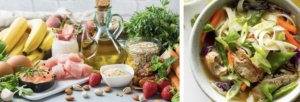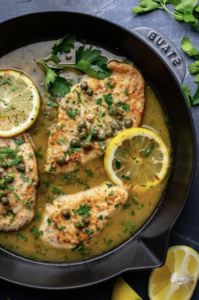At The Physiosports Group we like to make the distinction between a ‘healthspan’ and a ‘lifespan’.
Of course we want you all to live a long life, but our aim is to ensure that your life is filled with good health, happiness, and vitality.
A key strategy to maximising your healthspan is to prioritise the management of inflammation as you age.

Managing ‘Inflammaging’ as a Priority.
‘Inflammaging’ refers to the chronic low-grade inflammation that occurs in our bodies as we age. That is, Inflammation naturally increases with age due to the immune system aging and becoming dysregulated.
This we really need to dial in our diet, movement and lifestyle measures as we age to avoid inflammation becoming chronic.

Chronic inflammation can damage our tissues and organs, leading to the development of chronic diseases, including:
- Osteoporosis
- Cardiovascular disease
- Cancer
- Depression and anxiety
- Alzheimer’s disease
- And all other autoimmune diseases
‘MediterrAsian’ Anti-inflammatory Nutrition.
Our Nutrition Consultant, Sonia Osborne, advocates a ‘MediterrAsian’ approach. That is, the Mediterranean Diet (which has been well researched), along with the benefits of an Asian Diet (which are highly nourishing, healing).

These diets include foods are particularly anti-inflammatory and can help to reduce inflammation in the body. These include:
- Fruits and vegetables (half your plate): Eat a wide variety of colour fruit and veg and ensure diversity. Berries, citrus fruits, leafy greens, cruciferous vegetables, onions, garlic and leek are particularly high in anti-inflammatory compounds.
- Fatty fish and seafood: Salmon, mackerel, and sardines are rich in omega-3 fatty acids, which have anti-inflammatory properties.
- Nuts and seeds: Walnuts, almonds, and chia seeds are good sources of anti-inflammatory omega-3 fatty acids, while nuts such as cashews and almonds also contain magnesium, which has been linked to reduced inflammation.
- Olives and olive oil
- Whole grains: Brown rice, quinoa, and oatmeal are rich in fibre which reduce in inflammation by feeding the gut and improving the pH of the body
- Beans/Legumes: Chickpeas, black beans, red kidney beans, lentils etc are high in fibre and phytonutrients, which reduce inflammation.
- Spices: Turmeric, ginger, and cinnamon have been shown to have anti-inflammatory effects.
- Bone Broth: The amino acids found in bone broth, including glycine and arginine, have strong anti-inflammatory effects.
- Green Tea: Green tea is high in a particular antioxidant that reduces oxidative stress.
- Supplements such as omega-3 fatty acids, Vitamin D, magnesium, Vitamin C, curcumin, and resveratrol have also been shown to have anti-inflammatory effects.
Reducing Inflammatory Foods.
In addition to increasing anti-inflammatory foods, we also recommend that you start reducing foods that promote inflammation.

Getting Started.
A lot of the suggested changes are so simple .. but they are often not easy to implement because change can be overwhelming and some habits are stubborn.
If you need support then we encourage you to book in with Sonia Osborne, our Nutrition Consultant and coach, who can guide you with a program customised for you and your individual needs.
Here is also a recipe that may inspire you.
In wellness,
Sonia
Sonia is a Nutrition Consultant, who works on Thursdays & Saturdays out of our Physiosports Brighton clinic. To find out more about Sonia click here. Or to book in all 9596 9110 or click here.
LEMON AND PARSLEY CHICKEN
This recipe is a perfect example of how simple natural ingredients can bring a meal to life. It is flavour-loaded and wonderfully anti-inflammatory. Lemons and fresh herbs are always a staple in my fridge, so this recipe is easy to put together, quick to cook, and a real crowd pleaser.

Ingredients: (serves 4)
- 1 Tablespoon olive oil
- 1.5 Tablespoons of olive oil (extra)
- 4 Chicken Breasts (sliced in half through middle if large)
- Cracked black pepper
- 2 Tablespoons capers
- 1 Teaspoon chili flakes (omit if kids don’t like)
- 1 Tablespoon finely grated lemon rind
- 2 Cloves garlic, sliced
- 2 Tablespoons lemon juice
- ½ Cup chopped parsley
Method:
Heat 1 tablespoon of oil in a medium-sized fry pan over medium-high heat. Sprinkle the chicken with the pepper and add to the pan. Cook for 4 minutes each side or until browned.
Add the extra oil, capers, chili, lemon rind and garlic, and cook for 1 minute. Add lemon juice and parsley.
Enjoy with a green salad!
Want to know more?
Send Sonia an email to sonia@physiosports.com.au, or book in to see her by clicking here.
